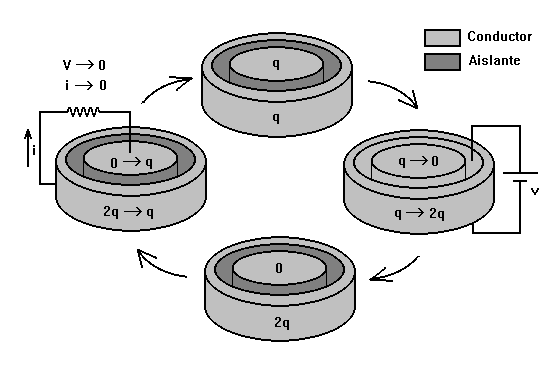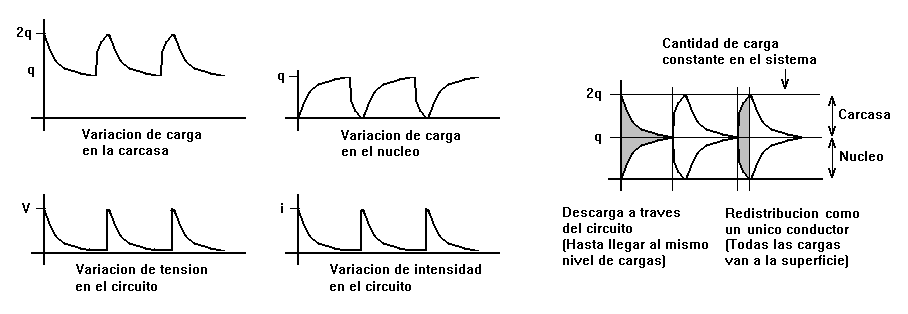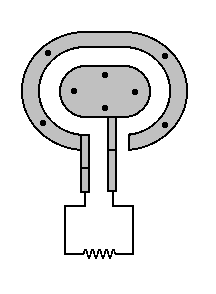
ELECTROSTATIC BUBBLE AS A PERPETUAL VOLTAGE BATTERY
DESCRIPTION
The system is made of two cilindrical metal plates charged at Q, and a kind of MOS transistor.
When no voltage is applied to the semiconductor, there is no electron's channel, so the system behaves like two isolated charged conductors.
When the semiconductor is excited, an electron's channel is made, and the system behaves like a unique conductor. Then, the electrons move to the surface through the channel.
The charges, due to their inner repulsion, goes to the surface by themselves, They redistribute naturally going to the skin. Later, we will separate this skin from the core conductor, so we will get all the charges on one terminal (skin), and no charge on the other (core). The working principle is shown below:
WORKING PRINCIPLE

1 - Two isolated conductors, charged at Q.
2 - One unique conductor, charged at 2Q. This charge goes to the surface.
3 - Two isolated conductors. One (skin) charged at 2Q, the other (core)has no free charges.
4 - Two isolated conductors with different charge, linked by circuit. Discharge proccess like a capacitor.
GRAPHICS
Here are some graphics:

EXPLANATIONS
The electrons always exert a force of repulsion to other electrons. That's why the electrons store on surface of conductors, because they can move freely inside. If they could, they will move to infinity. We will need to do nothing else.
The trick is that they scape one from each other, but in a way we can collect them in a region (skin) than we can use later as a store of charges of same value. When the system is configured like a unique conductor, it behaves like a fishing net of electrons. They "think" they are scaping one from each other, but in fact they're been collected to be used later.
When we've got the unique conductor configuration, the electrons scape to the skin of the system. Now, if we change into two separated conductors and connect them by circuit, the charges will continue expanding, to the new configuration of space, but also, while they are moving, we can use this flux of electrons to power a circuit. The charges will redistribute to be the same amount on the two conductors. The proccess is like a discharging capacitor. The electrons continue scaping one from the rest, until they rise the new space configuration.
We've got the charges distributed equally into the two conductors now. We need to get all the electrons only in one region again. How to recollect the electrons? If we change again the two conductors into a unique one, the electrons will redistribute. They will "think" they are scaping one from another, but in fact they are falling into our trap (skin). Now we've got the electrons again collected into a certain region, and we can start to discharge them like before. This cycle can repeat again and again.
That's why i call it electrostatic bubble, because it's like a water bubble, the skin is made of soap and water, and the core is made of air.
Usually (in normal batteries) we use chemical energy to get the electrons collected into one terminal. Once the electrons goes to the other terminal, the battery is empty, and we need to use another one. The batteries are a ONE USE device... But here is a method to use no energy to redistribute the charges, they do by themselves. They always try to scape from the rest, but we choose if they are ordered into a region respect another region (and then there is potential, or energy) or disordered (equally distributed, no potential, no energy) by changing the spatial conditions. This change on conditions can cost less than the effects we can obtain from this change.

Now i see electric energy as a difference on spatial amount of charges between two places. Due to this fact, the charges can be ordered or disordered if we change the spatial conditions, or references. There is no need to force the electrons to go to a certain region (that's what we are doing now), but letting them go where they naturally want to go, but with our desired restrictions. We can use the natural repulsion force of equal charges to get them ordered or distributed on a certain region, but this region must be of an specific shape.
We force the electrons to be in a region with the shape we want to store them, that's the error, The electrons by themselves will store if the region has an specific shape, the shape the charges will go to by the action of their inner repulsion forces.
CONCLUSIONS
We can obtain voltage and current continuously without expend the electrons source (the electrons are always the same).
The power needed to control the proccess can be less than dissipated power by the circuit (This power is function of the level of pre-charge Q of the system).